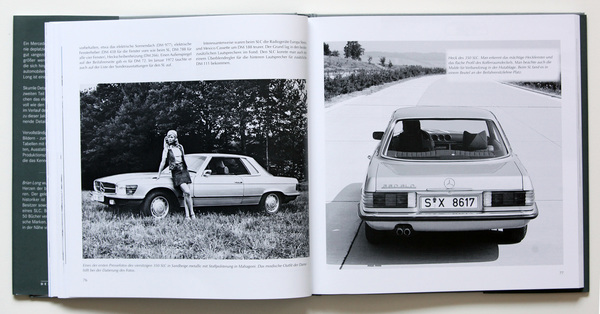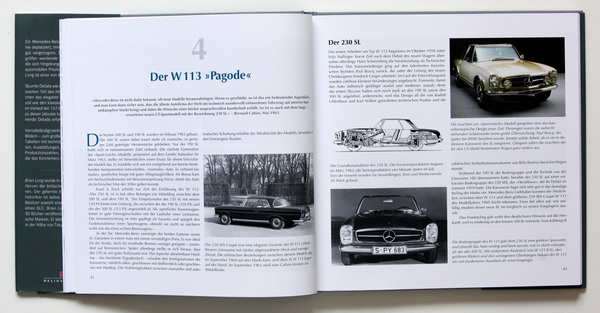For almost two decades - from 1971 to 1989 - the R/C 107 model series was at the bottom of the small, blue price lists for Mercedes vehicles at Daimler-Benz, before the coupés were replaced by the stockier C 126 model series in 1980 and the roadsters by the sportier R 129 model series. Even more than the S-Class of the W 116 model series introduced in 1971, the SL models have shaped the brand's image to this day.
It is therefore not surprising that countless books have been dedicated to this model.

The monograph by Brian Long has been published by Delius Klasing in its 3rd German edition, and the demand on the classic car market is also having an impact on the book market.
The SL and the SLC
In the 1970s, the SL and the SLC expressed Mercedes' claim to build the best cars in the world. Nothing seemed too elaborate to make the vehicles appear as if they had been carved from a solid block. SL stood for Super Leicht in reference to the 300 SL sports car, which had come home victorious from Le Mans in the 1950s. However, Porsche's neighbors in Stuttgart had already pinned the term to their lapels when they launched the 356/02 SL in 1951. They competed in the endurance classic with the particularly lightweight aluminum coupés from Gmünd.
Well, the new Mercedes model series was no longer quite as light as its SL forefathers. Unladen weights well above the 1.5-ton mark also express the claim to be less sporty, but particularly comfortable and safe. With the introduction of the Roadster and Coupé, Mercedes underlined the brand's claim to build the best cars in the world. A nimbus that would certainly last until the 1980s, before BMW, first with the 7 Series (E 32) and the wonderful 12-cylinder and then Audi with the A8 (D2) with aluminum body set innovative standards that changed the claim as the sole supplier to the Daimler-Benz court and elite.
18 years of the top model
Author Brian Long, himself a 300 SL and 450 SLC driver, devotes more than 200 pages to the 107 model series, and his enthusiasm for the roadster and coupé as well as for the company's history and models in general and in detail can be read from every line.
Before he gets to the actual history of the book, Long introduces the line of ancestors. Starting with the sporting ambitions of Daimler and Benz even before the First World War, the book works its way forward to the period after 1945, when Mercedes rises from the ashes like a phoenix and continuously lays claim to its place in the Olympus of global automobile construction with the sporting successes of the 300 SL and the 300 SLR, including at Le Mans, as well as a cautious but high-quality model policy, at the latest with the 600 model.

The most important predecessors of the 107 model series are presented in a concise but precise manner over a good 50 pages. Technology, design and people are the common thread that ultimately leads to the introduction of the Coupé and Roadster in 1971.
The fact that the SL in particular was able to remain in the range for so long underlines how far Mercedes had come in some areas and how consistently the model was updated in terms of both environmental regulations and the constantly growing comfort requirements for this niche model. The already developed successor was shelved in favor of the W 201 and the W 124. The SLC always had to search for its fans and, despite automatic-drive rally victories as the 450 SLC 5.0 and 500 SLC, was never able to translate its sporting aspirations so clearly into sales acceptance. The situation was quite different for the Roadster, which became synonymous with beauty, success and wealth in countless television series such as Dallas, Denver Clan and films, particularly in the USA.
Timeless elegance
Long takes a detailed look back at the development and construction of both models. Always well illustrated and richly described, he traces the turning point that the model series represents for Mercedes, as described above. As examples, the author mentions the louvre windows of the SLC or the Fuchs forged rims as well as extras such as headlight cleaning systems or crash tests. He also sheds light on the details and devotes an entire chapter to motorsport. Of course, evolution is not neglected during the long construction period. Both in terms of technology and equipment, it always reads smoothly and as a coherent story.
The British author, who now lives in Japan, also repeatedly refers to the export markets, in particular the USA, interestingly of course Japan and his native Great Britain. For enthusiasts of the model series, this opens up completely new information, especially on models that were not officially offered in Europe, such as the 560 SL. The SL era of the 107 series at Mercedes came to an end with the extensive model update in 1985. Demand was unbroken and increased again towards the end. It was foreseeable that a successor was waiting in the wings on the production lines. The switch to a new engine family made the SL fit for the second half of the 1980s. Seen in this light, a 30-year-old SL from 1989 is a high-tech classic that can only be compared with a 1971 model in terms of its appearance.
Saving the best for last
Alongside the 600 Mercedes and the 1972 S-Class, the R/C 107 series probably marks the end of an automotive era. Nothing seemed to be able to stop Mercedes' ambition to build the best cars. Conservatively, the focus was less on avant-garde solutions and more on American taste. In the sixties, this was not only reprehensible from a German point of view. It is against this background that Brian Long describes the history of the SL/SLC, which also makes it clear that it is necessary to go into so much detail on the one hand and to cover a model series so fluently on the other. Despite many technical modifications, the SL was even more of a favorite with buyers than the SLC, and it was precisely this longing for distinguished power, coupled with German reliability, that gave the SL/SLC the edge over exotic cars from Italy or the competition from Great Britain and Germany at the beginning of the 1970s.
This did not change at the end of the 1980s, with the chrome-laden body, the mighty, striking rear lights in a ribbed design and the wood-paneled dashboard, the SL was the last representative of its class. Where others ducked their noses into the wind tunnel, shingling weight through plastic bumpers, the 107 series at Mercedes from 1971 to 1989 claimed to be something special. Developed before the oil crisis in the 1960s, this model series is still a representative of absolute uncompromisingness. Where should the journey go? To the moon? They would probably have preferred to drive an SL there too.
The W 123 is often celebrated as the last true Mercedes, but it was only a mid-range model and the SL/SLC was only just getting started after the SL's engine had been phased out. In addition, the W 116 and W 123 benefited from countless developments that had already been introduced here. When Daimler-Benz celebrated its 100th birthday in 1986, the SL was freshly revised for its last production run.
Even the name 300 SL was no sacrilege and with the 500/560 SL, Stuttgart was not too shy to carry out extensive model maintenance. The reward was global acceptance as an absolute luxury brand in the 1970s and 1980s, which belonged in the fleets of state and royal families, but which potentates and dictators, pimps and directors could not say no to either. You were somebody in a Mercedes. And it was not only the brand that benefited from this, but also the W 123.
SL = easy to read
Brian Long's book on the 107 series covers the history of the Mercedes SL and SLC in over 200 pages. In doing so, the author goes into the deeply eventful history of the sports cars at Mercedes as well as the successor model to the SL, the R 129.

The history of development is always broadly illuminated in this monograph. The book succeeds in presenting the many development stages of the long-seller in numerous facets.
The author cannot conceal his British origins, but from a German perspective, the focus is on rather unknown aspects of the export markets. Technology enthusiasts, on the other hand, will miss some details here and there. However, this can be painlessly overlooked in view of what is on offer.

Anyone interested in this model series will certainly enjoy this book at a price of EUR 39.90. This is probably also the opinion of others, as the 3rd edition allows this conclusion to be drawn.
Bibliographical details
- Title: Mercedes-Benz SL and SLC
- Author: Brian Long
- Language: German
- Publisher: Delius Klasing
- Edition: 3rd edition 2019
- Format: 256 x 256 mm, hardcover
- Size: 208 pages with dust jacket, almost 200 photos (color and b/w) and over 50 illustrations (color and b/w)
- ISBN: 978-3-7688-3422-3
- Price: EUR 39.90
- Order/buy: Online at amazon.de, online at the publisher delius-klasing.de or in a good bookshop






















